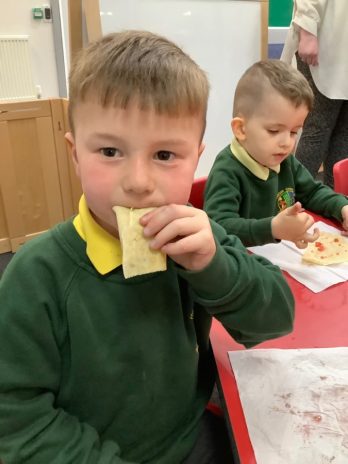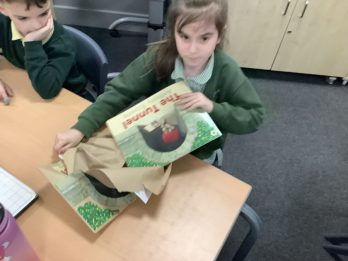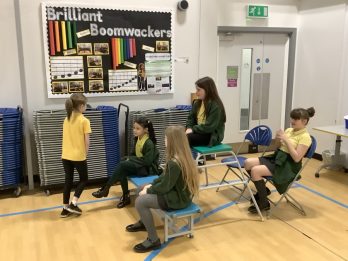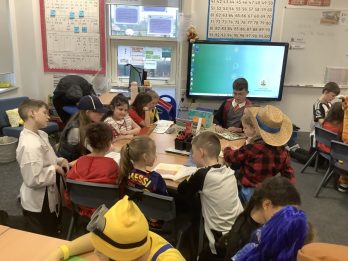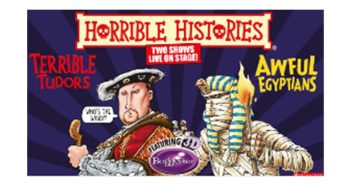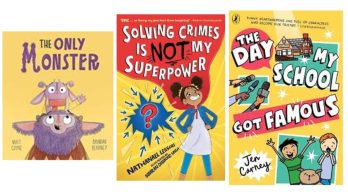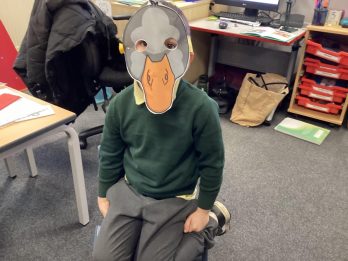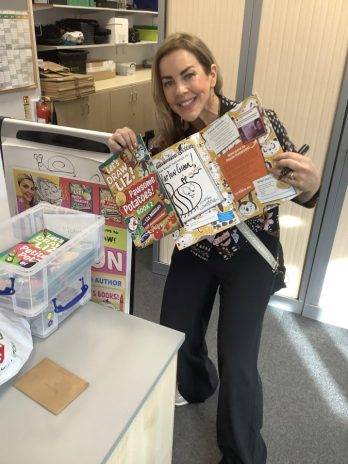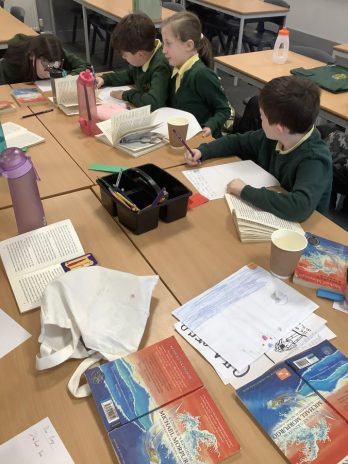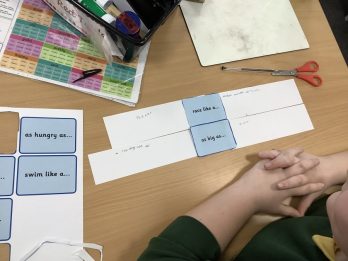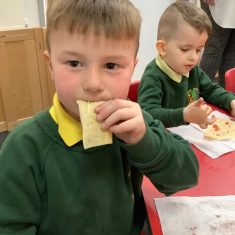 This week in Reception Class, we joyfully celebrated Shrove Tuesday, a delightful tradition that marks the beginning of Lent. To enhance our understanding of this special day, we read the story, Mr Wolf’s Pancakes. This engaging tale captivated the children’s imaginations and sparked their enthusia
This week in Reception Class, we joyfully celebrated Shrove Tuesday, a delightful tradition that marks the beginning of Lent. To enhance our understanding of this special day, we read the story, Mr Wolf’s Pancakes. This engaging tale captivated the children’s imaginations and sparked their enthusia
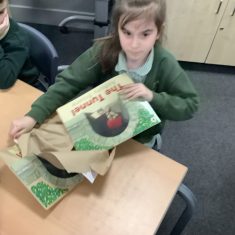 This week in English, Year Two have started their new book for this half term. They received a parcel and a letter and were very excited to discover what was inside. First, they read the letter which explained that they needed to unwrap each layer of their parcel to discover clues that would tell th
This week in English, Year Two have started their new book for this half term. They received a parcel and a letter and were very excited to discover what was inside. First, they read the letter which explained that they needed to unwrap each layer of their parcel to discover clues that would tell th
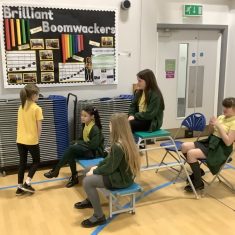 This week, the children got an insight into what they would be learning about in Year 6 – Shakespeare! The children were introduced to the story of Macbeth. After hearing the story, the children were put into groups and tasked with coming up with a maximum of five freeze frames to retell their sec
This week, the children got an insight into what they would be learning about in Year 6 – Shakespeare! The children were introduced to the story of Macbeth. After hearing the story, the children were put into groups and tasked with coming up with a maximum of five freeze frames to retell their sec
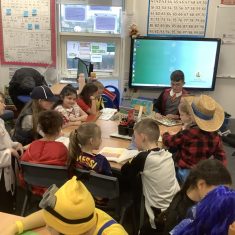 World Book Day is an annual celebration of authors, illustrators, books and the joy of reading. It encourages children and families to find the fun and enjoyment in reading because reading for pleasure changes lives. At Harlow Green, World Book Day is one of the highlights of the academic year. Ch
World Book Day is an annual celebration of authors, illustrators, books and the joy of reading. It encourages children and families to find the fun and enjoyment in reading because reading for pleasure changes lives. At Harlow Green, World Book Day is one of the highlights of the academic year. Ch
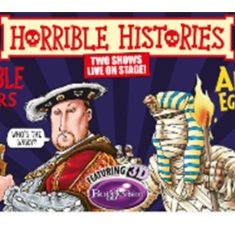 Any Horrible Histories lovers out there? Horrible Histories is coming to Sunderland Empire Theatre from Thu 20 Mar – Sat 22 Mar 2025 and there are still tickets available. It is sure to be a ghastly show! Article 31: We all have the right to rest, relax and play.
Any Horrible Histories lovers out there? Horrible Histories is coming to Sunderland Empire Theatre from Thu 20 Mar – Sat 22 Mar 2025 and there are still tickets available. It is sure to be a ghastly show! Article 31: We all have the right to rest, relax and play.
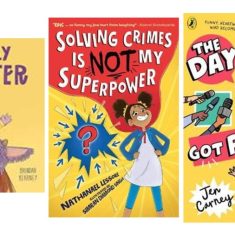 This week, we have celebrated world Book Day in school. Part of this celebration, was about looking at new books that the children might like and the teachers being able to offer some advice about authors and the latest books in the shops. With money from their sponsored read, the children are going
This week, we have celebrated world Book Day in school. Part of this celebration, was about looking at new books that the children might like and the teachers being able to offer some advice about authors and the latest books in the shops. With money from their sponsored read, the children are going
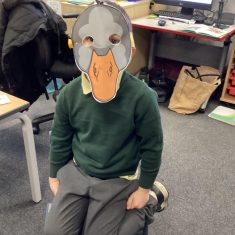 This week the children in Year 1 have started to explore The Ugly Duckling written by Jackie Walter and Sarah Horne. To begin, the children used feathers and other collage materials to create pictures of Mother Duck and the Ugly Duckling. Next, they predicted what would hatch out of the final eg
This week the children in Year 1 have started to explore The Ugly Duckling written by Jackie Walter and Sarah Horne. To begin, the children used feathers and other collage materials to create pictures of Mother Duck and the Ugly Duckling. Next, they predicted what would hatch out of the final eg
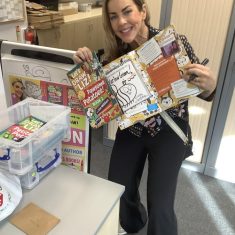 Over three days this week, the children across the whole school were spell-bound as they were visited by the illustrator and author Liz Million. Liz writes, illustrates and publishes her own books as well as illustrating for other authors and working in schools. She talked to the children about her
Over three days this week, the children across the whole school were spell-bound as they were visited by the illustrator and author Liz Million. Liz writes, illustrates and publishes her own books as well as illustrating for other authors and working in schools. She talked to the children about her
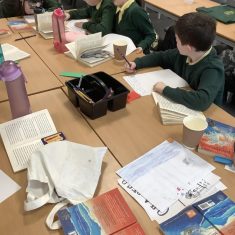 Reading for pleasure and promoting a life-long love of books is a key aim of the school’s curriculum and, this half-term, Mr Allen has run an after-school book club where children have read and discussed a book together each Thursday. The book that was chose was ‘Kensuke’s Kingdom’ by Michael Morpur
Reading for pleasure and promoting a life-long love of books is a key aim of the school’s curriculum and, this half-term, Mr Allen has run an after-school book club where children have read and discussed a book together each Thursday. The book that was chose was ‘Kensuke’s Kingdom’ by Michael Morpur
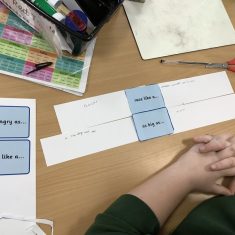 This week, the children in Year 5 have been writing sentence stackers in preparation for their next piece of writing. Today, the children were introduced to the language feature similes. The children learnt that similes compare something to something else using the words ‘as’ or ‘like’. After iden
This week, the children in Year 5 have been writing sentence stackers in preparation for their next piece of writing. Today, the children were introduced to the language feature similes. The children learnt that similes compare something to something else using the words ‘as’ or ‘like’. After iden
